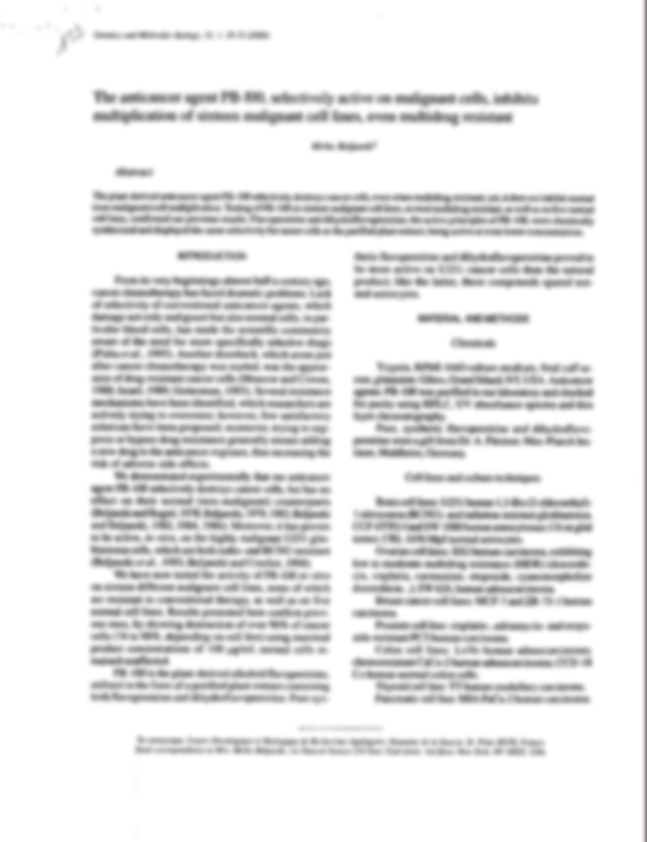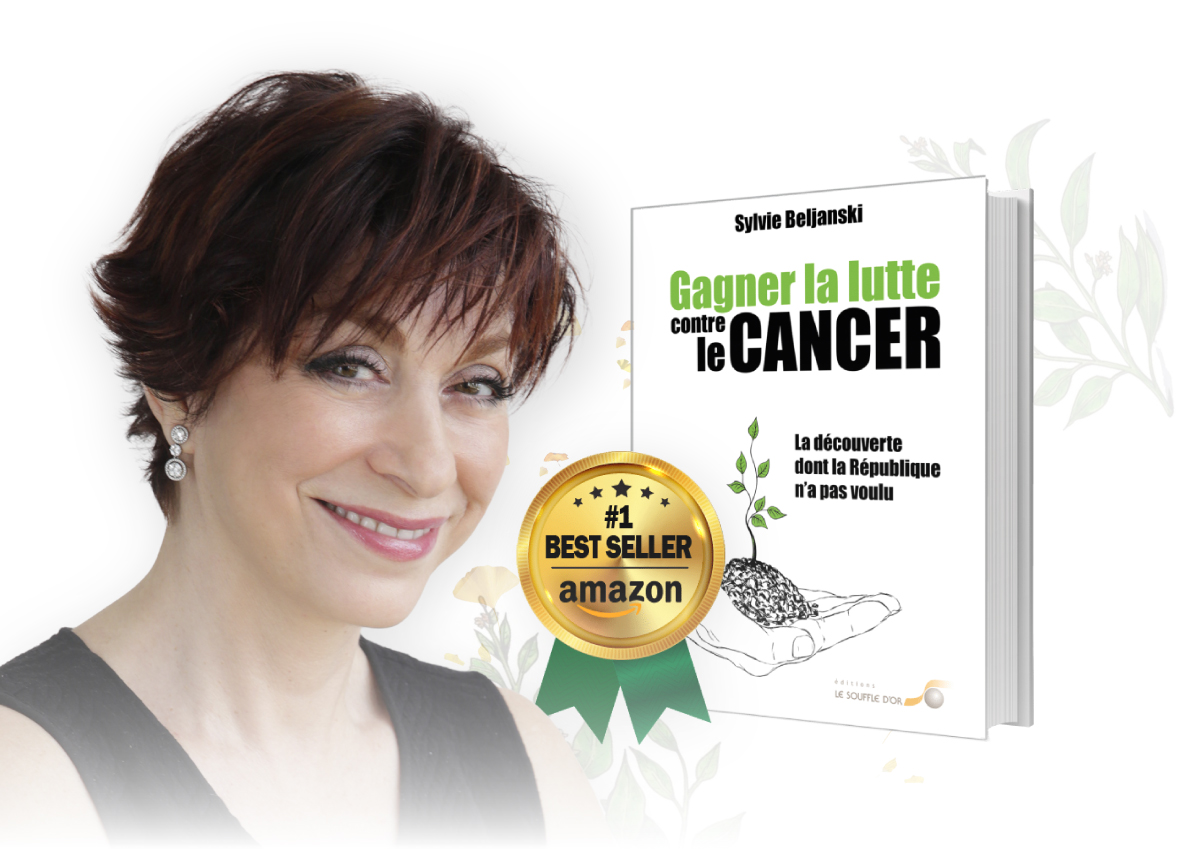123 – Le PB100 : Inhibiteur sélectif puissant de la multiplication des cellules de glioblastome humain résistantes au BCNU
Anticancer Research, vol.13, n°6A, Nov. Dec. 1993, pp. 2301-2308.
Available online in French, summary in English
ABSTRACT: Major drawbacks to present-day cancer chemotherapy are its intrinsic lack of selectivity for tumour cells, resulting in severe damage to normal rapidly dividing cells, and the widespread emergence of drug resistance. Here experimental evidence is presented demonstrating that PB-100, a beta-carboline alkaloid, selectively inhibits in vitro multiplication of human BCNU-resistant glioblastoma cells (U251), but has no effect on normal astrocyte (CRL 1656) multiplication. PB-100 activity is dose-dependent. In the presence of ferritin or CaCl2, which are highly mitogenic for glioblastoma cells, higher doses of the alkaloid are required to inhibit multiplication completely. PB-100 is one of several compounds which were selected for their specific action on cancer DNA and cells, together with lack of activity on normal DNA and cells. Both the selectivity of PB-100 and its ability to overcome drug resistance stem from its effect on cancer DNA secondary structure. This activity is described and discussed, and therapeutic applications are mentioned..
ABSTRACT: Major drawbacks to present-day cancer chemotherapy are its intrinsic lack of selectivity for tumour cells, resulting in severe damage to normal rapidly dividing cells, and the widespread emergence of drug resistance. Here experimental evidence is presented demonstrating that PB-100, a beta-carboline alkaloid, selectively inhibits in vitro multiplication of human BCNU-resistant glioblastoma cells (U251), but has no effect on normal astrocyte (CRL 1656) multiplication. PB-100 activity is dose-dependent. In the presence of ferritin or CaCl2, which are highly mitogenic for glioblastoma cells, higher doses of the alkaloid are required to inhibit multiplication completely. PB-100 is one of several compounds which were selected for their specific action on cancer DNA and cells, together with lack of activity on normal DNA and cells. Both the selectivity of PB-100 and its ability to overcome drug resistance stem from its effect on cancer DNA secondary structure. This activity is described and discussed, and therapeutic applications are mentioned..
122 – A New Approach to Cancer Therapy
Proceedings of the international seminar: Traditional Medicine: a Challenge of the 21st Century, 7-9 Nov. 1992, Calcutta (ed. in chief Biswapati Mukherjee).
Available in English only
ABSTRACT: Cell function and differentiation are the outcome of multiple and complex events. Information contained in the genes is transferred to the enzymes and machinery responsible for protein synthesis via sophisticated biochemical pathways, some of which, despite their intricacy, are now well documented. Conversely, genes receive information which modulates their activity. Many different molecules are able to bind to nucleic acids (deoxyribonucleic acid, DNA, and ribonucleic acid, RNA), thereby modifying gene activity as well as that of various enzymes connected with it. It is well established that the effect of endogenous or exogenous molecules on such fundamental processes of cell life as DNA duplication, transcription and translation may dramatically affect other biochemical processes both downstream and upstream. Binding of any molecule to DNA may influence cell life “for better or for worse”.
ABSTRACT: Cell function and differentiation are the outcome of multiple and complex events. Information contained in the genes is transferred to the enzymes and machinery responsible for protein synthesis via sophisticated biochemical pathways, some of which, despite their intricacy, are now well documented. Conversely, genes receive information which modulates their activity. Many different molecules are able to bind to nucleic acids (deoxyribonucleic acid, DNA, and ribonucleic acid, RNA), thereby modifying gene activity as well as that of various enzymes connected with it. It is well established that the effect of endogenous or exogenous molecules on such fundamental processes of cell life as DNA duplication, transcription and translation may dramatically affect other biochemical processes both downstream and upstream. Binding of any molecule to DNA may influence cell life “for better or for worse”.
121 – Overview: BLRs as Inducers of In Vivo Leucocyte and Platelet Genesis
Deutsche Zeitschrift für Onkologie, 24, 2, 1992, pp. 41-46.
Deutsche Zeitschrift für Onkologie, 24, 2, 1992, pp. 41-46.
120 – Radioprotection of Irradiated Mice – Mechanisms and Synergistic Action of WR-2721 and R.L.B.
Deutsche Zeitschrift für Onkologie, 23, 6, 1991, pp. 155-159.
Available in English only. Summary in German.
ABSTRACT: Radioprotector WR-2721 (S-2 (3-amino-propylamino)-ethyl-phosphorothioic acid) includes in vitro the contraction of DNA chains, but only when these originate from normal cells. Chain contraction results in a decrease of UV absorbance at 260 nm (hypochromicity). A correlation exists between DNA hypercromicity induced by WR-2721 and decrease in the synthesis of the same DNAs used as templates in the presence of this radioprotector. In contrast, the compound has no effect either on secondary structure of DNAs from various cancer cells or on in vitro synthesis of these DNAs. In association with R.L.B. which selectively prime replication of DNAs from normal haematopoietic cells, WR-2721, used at ralatively low doses, protects mice against lethal doses of gamma radiation. Efficient survival rates are obtained. The mechanism of this protection by WR-2721 and R.L.B. is discussed.
ABSTRACT: Radioprotector WR-2721 (S-2 (3-amino-propylamino)-ethyl-phosphorothioic acid) includes in vitro the contraction of DNA chains, but only when these originate from normal cells. Chain contraction results in a decrease of UV absorbance at 260 nm (hypochromicity). A correlation exists between DNA hypercromicity induced by WR-2721 and decrease in the synthesis of the same DNAs used as templates in the presence of this radioprotector. In contrast, the compound has no effect either on secondary structure of DNAs from various cancer cells or on in vitro synthesis of these DNAs. In association with R.L.B. which selectively prime replication of DNAs from normal haematopoietic cells, WR-2721, used at ralatively low doses, protects mice against lethal doses of gamma radiation. Efficient survival rates are obtained. The mechanism of this protection by WR-2721 and R.L.B. is discussed.
119 – Reverse Transcriptases in Bacteria: Small RNAs as Genetic Vectors and Biological Modulators
Brazil. J. Genetics, 14, 4, 1991, pp. 873-896.
Available in English only
ABSTRACT: In 1970, with my group at the Pasteur Institute in Paris, I observed that showdomycin resistant Escherichia coli cells excrete into their culture medium a small RNA, about 160 nucleotides long, rich in purine bases. This RNA transforms wild bacteria (E. coli and Agrobacterium tumefaciens) into transformants which exhibit new stable biochemical and physical characteristics. Thus A tumefaciens once transformed by E. coli transforming RNA, partially or often totally loses its oncogenic potentialities and acquires new properties. It appeared that reverse transcriptase might give transforming RNA the means of integrating into the genome of the transformed organisms the modifications it vectored. We demonstrated (1971-1972) that bacterial reverse transcriptase was involved in this process. In the course of our studies on bacterial transformation, we devised a technique which led to the discovery, first of RNA free reverse transcriptase in bacteria, then of RNA-bound reverse transcriptase which is easily distinguishable from DNA-dependent-DNA-polymerase. In 1989 several american scientists rediscovered reverse transcriptase in E. coli.
ABSTRACT: In 1970, with my group at the Pasteur Institute in Paris, I observed that showdomycin resistant Escherichia coli cells excrete into their culture medium a small RNA, about 160 nucleotides long, rich in purine bases. This RNA transforms wild bacteria (E. coli and Agrobacterium tumefaciens) into transformants which exhibit new stable biochemical and physical characteristics. Thus A tumefaciens once transformed by E. coli transforming RNA, partially or often totally loses its oncogenic potentialities and acquires new properties. It appeared that reverse transcriptase might give transforming RNA the means of integrating into the genome of the transformed organisms the modifications it vectored. We demonstrated (1971-1972) that bacterial reverse transcriptase was involved in this process. In the course of our studies on bacterial transformation, we devised a technique which led to the discovery, first of RNA free reverse transcriptase in bacteria, then of RNA-bound reverse transcriptase which is easily distinguishable from DNA-dependent-DNA-polymerase. In 1989 several american scientists rediscovered reverse transcriptase in E. coli.
118 – RNA Fragments (RLB) and Tolerance of Cytostatic Treatments in Hematology: A Preliminary Study about Two Non-Hodgkin Malignant Lymphoma Cases
Deutsche Zeitschrift für Onkologie, 23, 2, 1991, pp. 33-35.
Available in French only
ABSTRACT: Assays were carried out with short-chain RNA fragments in order to determine whether they can prevent or decrease chemotherapy-induced neutropenia and thrombopenia, as well as to evaluate side effects. We studied both first patients, 65 and 77 years old with non-Hodgkin lymphoma. The short-chain RNAs, administred bysublingual way every second day, appear useful in this indication. Neutrophils and platelets are significantly increased. In addition, tolerance of the RNA fragment is good and no side effect is observed. Chemotherapy protocols could be followed without treatment.
ABSTRACT: Assays were carried out with short-chain RNA fragments in order to determine whether they can prevent or decrease chemotherapy-induced neutropenia and thrombopenia, as well as to evaluate side effects. We studied both first patients, 65 and 77 years old with non-Hodgkin lymphoma. The short-chain RNAs, administred bysublingual way every second day, appear useful in this indication. Neutrophils and platelets are significantly increased. In addition, tolerance of the RNA fragment is good and no side effect is observed. Chemotherapy protocols could be followed without treatment.
117 – Cancer et Sida. Nouvelles approches thérapeutiques
5èmes Entretiens Internationaux de Monaco, 21-24 novembre 1990 (ed. du Rocher), pp. 25-37.
Available in French only
ABSTRACT: La sélectivité d’action des substances est une notion aussi nouvelle que fondamentale. Alors que toutes les autres solutions jusqu’ici offertes sont brutales, toxiques (les médicaments s’incorporant souvent sans retour dans les gènes), est offert une alternative ciblée, de toute sécurité, multifocale afin que le virus soit détruit, l’immunité protégée et l’équilibre rétabli, seules conditions pour une vie de qualité se dirigeant jour après jour vers la “guérison”..
ABSTRACT: La sélectivité d’action des substances est une notion aussi nouvelle que fondamentale. Alors que toutes les autres solutions jusqu’ici offertes sont brutales, toxiques (les médicaments s’incorporant souvent sans retour dans les gènes), est offert une alternative ciblée, de toute sécurité, multifocale afin que le virus soit détruit, l’immunité protégée et l’équilibre rétabli, seules conditions pour une vie de qualité se dirigeant jour après jour vers la “guérison”..
116 – Cancer Therapy: A New Approach
Deutsche Zeitschrift für Onkologie 5, 22, 1990, pp. 145-152.
Available in German only
Available in German only
115 – Résultats préliminaires de l’emploi des trois alcaloïdes sur des carcinomes prostatiques
In Tumori, Institute Nationale per le studio ed la cura dei tumori (ed. Lambrosiana), Vol. 75, suppl. 4, 1989.
“Resultati preliminari dell’impiego di tre alcaloidi nel carcinoma prostatico”
*Dr. Maurizio GRANDI, membre de l’académie des sciences de Rome
Available in French only
ABSTRACT: Nous avons étudié l’effet des alcaloïdes : Alstonine, Serpentime et Sempervirine, en association avec la radiothérapie sur 5 patients ayant un carcinome prostatique. Ces résultats confirment ceux déja obtenus en laboratoire sur la reconnaissance sélective du DNA néoplasique.
ABSTRACT: Nous avons étudié l’effet des alcaloïdes : Alstonine, Serpentime et Sempervirine, en association avec la radiothérapie sur 5 patients ayant un carcinome prostatique. Ces résultats confirment ceux déja obtenus en laboratoire sur la reconnaissance sélective du DNA néoplasique.
114 – Neoplastic Characteristics of the DNA Found in the Plasma of Cancer Patients
Oncology, 46, 1989, pp. 318-322.
Available in English only
ABSTRACT: About one third of patients with various malignant diseases were found to have extractable amounts of DNA in their plasma whereas no DNA could be detected in normal controls. Using the test established by one of us (M.B.), which is based on decreased strand stability of cancer cell DNA, we have found that several plasma DNA originate from cancer cells.
ABSTRACT: About one third of patients with various malignant diseases were found to have extractable amounts of DNA in their plasma whereas no DNA could be detected in normal controls. Using the test established by one of us (M.B.), which is based on decreased strand stability of cancer cell DNA, we have found that several plasma DNA originate from cancer cells.




